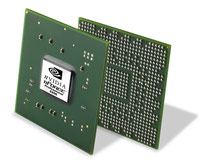nForce Professional 2200/2050 Launched
Chipset Technologies

Here we explain the new and improved features that NVIDIA has integrated in their new professional chipsets. These technologies range from new Dual GPU Support all the way to their improved fifth generation HyperTransport technology.
Dual GPU Support
One of the most exciting features of the new NVIDIA nForce Professional MCPs is that they provide support for two full x16 PCI Express GPUs on a workstation motherboard. Prior to this chipset, when an end user was running SLI cards they were splitting the single x16 link. Therefore we should expect to see better performance with SLI technology over previous SLI implementations. Those with dual NVIDIA Quadro cards should notice that SLI dramatically scales up graphics performance over running a single Quadro GPU.
PCI EXPRESS
The NVIDIA nForce Professional 2000 series MCPs integrate an advanced PCI Express architecture that can be configured to support the latest industry standard PCI Express cards. Both the 2200 and 2050 chips include 20 PCI Express lanes that can be mapped to 4 controllers in various ways. This will allow system designers to have flexibility on their design and implementation to support x16, x8, x4 and x1 PCI Express links. In addition, the NVIDIA nForce Professional 2200 and 2050 chips can be combined to scale to 40 or more PCI Express lanes. For those who need high end servers the 2200 can be used in combination with three 2050 chips allowing system designers to have 80 PCI Express lanes! If that isn’t impressive enough the NVIDIA nForce Professional MCPs also support Virtual Channels (VC) on all the PCI Express links. In layman’s terms VC’s will provide guaranteed bandwidth and latency for time-sensitive traffic.
NVIDIA NFORCE MEDIASHIELD PROFESSIONAL STORAGE
The nForce Mediashield Professional Storage system sounds tough, but really just consists of technology that we already know about. The mediasheild is marketing termonology for NVIDIA’s RAID and SATA 3Gb/s drive support. The take home message here is that all your business critical data is kept in a reliable, scalable, and accessible manner.
RAID
Provides a simple point and click wizard-based interface for creating and managing multi-disk storage configurations. Allows multi-disk designs to be set up for maximum performance (RAID 0), for data protection (RAID 1), or for a combination of both performance and protection (RAID 0+1). Also allows RAID volumes to be converted from one configuration to another with a single operation. Uniquely allows users to assign an extra disk to any RAID volume so that should a disk failure occur, NVIDIA RAID will automatically remove the failed disk and replace it with the spare while the system is still being used.SATA 3Gb/s
Take advantage of the latest SATA-2 3Gb/s hard disk drives with full support for native and tagged command queuing, and for hot plug. For those who may not know Tagged Command Queueing (TCQ) allows the kernel to send several asynchronous requests at once to a block device. The device can service the requests as it sees fit; the advantage being that the device can arrange the transfers as best suits the device hardware. TCQ works for both reads and writes. On the other hand, Native command queuing provides higher disk performance in a multi-threaded environment by performing out-of-order disk accesses.
NVIDIA nForce Professional Networking
Like the nForce Professional Storage, Professional Networking comprises of two parts: NVIDIA’s Native Gigabit Ethernet paired with TCP/IP Hardware Offload. The Gigabit Ethernet is not a new technology anymore, but paired with the Hardware Offload, NVIDIA is attempting to bring hardware efficiency to a higher priority in their workstation implementations.
TCP/IP Hardware Offload
TCP/IP Hardware Offload capability is built in to the native Gigabit Ethernet controller on the NVIDIA nForce Professional MCPs. This dramatically lowers the CPU utilization when processing network traffic at gigabit speeds. The hardware offload is also fully compliant with Microsoft’s Chimney architecture. As we know with graphics, hardware rendering is much, much faster than software rendering. So the more utilization we can put on hardware, the less work the Operating System has to do, which frees up CPU cycles.
NVIDIA nForce Professional Security
Very related to the nForce Professional Networking, Professional Security offers NVIDIA’s Trademarked ActiveArmor technology as well as a configurable firewall. These two technologies give the NVIDIA nForce Professional Security feature the ability to efficiently protect your computer from intruders and viruses, given the proper settings.
NVIDIA ActiveArmor?
ActiveArmor? enhances network security while delivering the highest system performance by offloading CPU-intensive packet filtering tasks in hardware, thus providing users with a networking environment that is both fast and secure. This is just another task that the CPU does not have to worry about with the new nForce Professional Chipsets!NVIDIA Firewall
The NVIDIA Firewall protects your workstation from intruders by filtering unauthorized traffic. Integrated into NVIDIA nForce Professional MCPs, it provides professional-grade traffic management features — remote access, configuration, and monitoring — and is easy to use and setup via a user friendly wizard. NVIDIA Firewall also utilizes NVIDIA ActiveArmor? secure networking engine.
HyperTransport Technology
NVIDIA’s fifth generation HyperTransport design integrates tightly with the AMD Opteron Direct Connect Architecture to deliver leading-edge 32-bit and 64-bit performance. HyperTransport is a state-of-the-art I/O bus interface — up to 8.0 GB/s — between the NVIDIA nForce Professional media and communications processor and the CPU. With each new chipset release, NVIDIA’s HyperTransport technology keeps improving in efficiency and productivity!

Comments are closed.